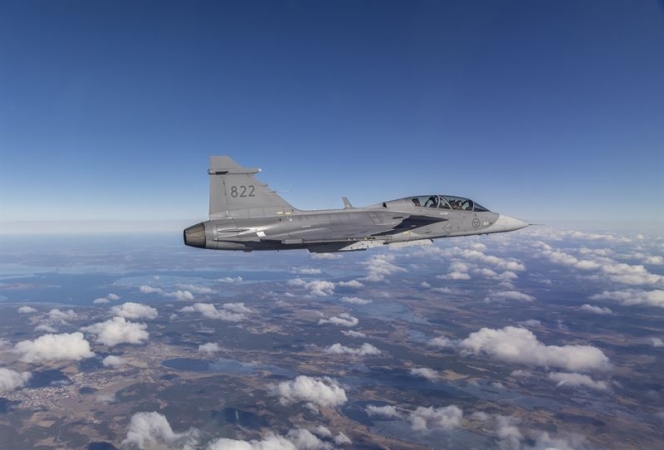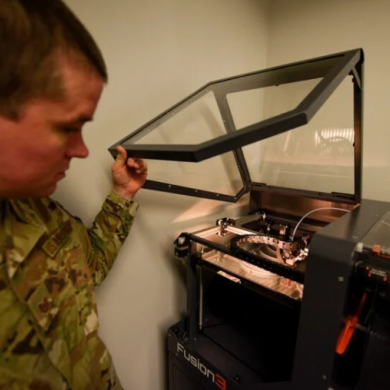May 19, 2020
"I've been so passionate about bringing in additive manufacturing, and small batch digital manufacturing, to help on aircraft parts availability," Air Force acquisition head Will Roper says.
By THERESA HITCHENSon May 15, 2020 at 12:54 PM
WASHINGTON: The Air and Space Forces are speeding efforts to adopt 3D printing as a major pillar of force sustainment, now making critical spare parts for weapon systems such as engine components for fighters and rockets.
“Additive and advanced manufacturing [has] been going like gangbusters across the Air Force and Space Force — printing thousands of parts for airplanes,” Air Force acquisition head Will Roper said yesterday. “We're starting to print parts for satellites, including propulsion.”
And today, the Air Force Rapid Sustainability Office (RSO) announced that it had reached a first milestone in its collaboration with General Electric to 3D print metal engine parts for aircraft — printing a metal sump pump for F-110 engines used by both F-15 and F-16 fighter jets. According to the announcement, the next phase of the program — Phase 1B , now being planned — will involve a family of parts on the TF34 engine, which has been in service for more than 40 years.
“The collaborative effort between the US Air Force and GE shows great promise toward the adoption of metal 3D printed parts as an option to solve the US Air Force's current and future sustainment challenges,” Col. Benjamin Boehm, director of propulsion at the Air Force Life Cycle Management Center (AFLCMC) said in a press release. “This capability provides an alternate method to source parts for legacy propulsion systems throughout their life cycle, especially when faced with a diminishing supplier base or when infrequent demands or low volume orders are not attractive to traditional manufacturers.”
GE originally approached the Air Force with the idea of a collaboration on 3D printed parts in 2019, and in April this year the service brought in the Defense Logistics Agency to help certify the GE-made parts for airworthiness.
ALCMC, as we reported way back in September at the Air Force Association shindig, has also been pushing to get its depots around the country certified to print their own spare parts, beginning with those not critical to life and death. Air Force leaders see additive manufacturing as key to resolving the service's serious problems in maintaining aging aircraft and infrastructure and lowering costs.
That said, the new 3D sump pump cover is an important piece of the engine.
“Compared to other parts on the F110 engine, the sump cover might have lower functionality, but is incredibly important. It needs to be durable, form a seal and it needs to work for the entire engine to function – which is of course critical on a single engine aircraft like the F-16,” said James Bonar, engineering manager at GE Additive.
The RSO-GE program is using a spiral development model, increasing the complexity and scale of parts printing with each phase. “In this program, complexity involves moving from simpler part identification, progressing to part and family of parts consolidation and eventually tackling complex components and systems, such as common core heat exchangers,” the press release said.
Roper told reporters yesterday in a Zoom briefing that due to the COVID-19 pandemic, RSO has transformed its planned Advanced Manufacturing Olympics, originally planned to coincide with the now-postponed Tokyo Summer Olympics in late July, to a virtual event to be held November. It will allow 3D printing companies to show off their wares to potential service customers via a number of challenges, including a “printer shoot-off” and a “Box of Parts” challenge where manufacturers will compete to create a drone part without a blueprint.
“We have been growing our network of small batch makers across the Air Force and Space Force,” Roper said. “I've been so passionate about bringing in additive manufacturing, and small batch digital manufacturing, to help on aircraft parts availability.”
The COVID-19 crises has proven the “additive” value of tapping into a network of small manufacturers as the Air Force has scrambled to obtain personal protective equipment for airmen at far-flung bases, he explained. Because many large producers of items like face masks are overwhelmed, the service set up the “Air Force Rapid Advanced Manufacturing Portal,” or “AFRAMP,” as a method of finding and vetting small producers to meet service needs.
“It's a portal where small batch manufacturers can make their capabilities known — show what they're able to produce — we vet them, and that then allows these small companies in aggregate to add up to large batch manufacturing,” Roper said. “We've already delivered over 11,000, different PPE devices to seven air bases that wouldn't have otherwise been able to get access for personal protective gear.”
His hope is to expand that portal to other types of advanced manufacturing in the future.
“I'm excited about scaling it up beyond just personal protective gear, and really having it be a one-stop-shop in the government for companies that can make things in small quantity — that can't mass produce, but can produce in mass if they're added up with a lot of their other sister companies.”
https://breakingdefense.com/2020/05/air-forces-roper-3d-printing-going-like-gangbusters/



